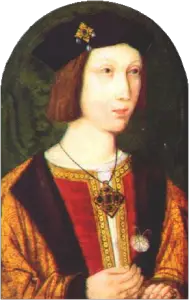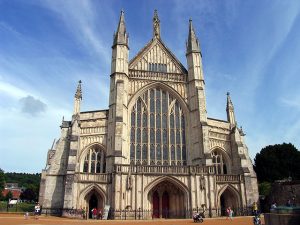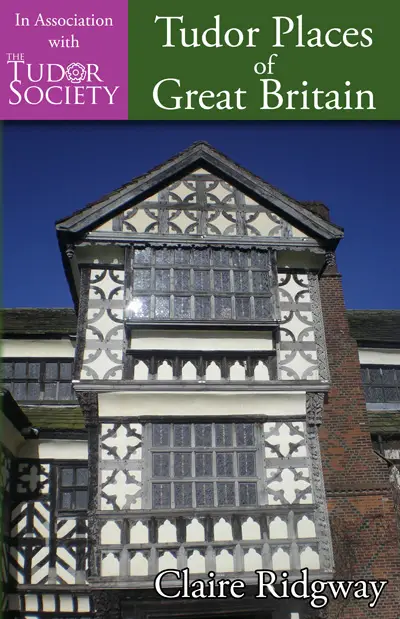 Thank you so much to historian and author Kristie Dean for writing this article for us.
Thank you so much to historian and author Kristie Dean for writing this article for us.
When I was writing my last book, I spent time researching Elizabeth of York and her role as a bridge between the York and Tudor dynasties. While Henry may have married Elizabeth in order to help secure his throne, it seems clear that he grew to love her, or at the very least, considered her a partner. This may have partly stemmed from a shared sense of responsibility for their children. When Arthur was born, Henry seized the moment to display the strength of his dynasty.
The christening of Arthur Tudor, heir to Henry VII, was a momentous event. After years of turmoil and war, the union of the Lancastrian and York families had produced an heir celebrated by both Henry VII and Elizabeth of York. In preparation for the birth, Elizabeth had been brought to Winchester Castle, but finding it in a state of disrepair had been taken to the nearby Priory of St Swithun instead.
Arthur's birth on 20 September 1486 was hailed with bonfires, and the joyous news was quickly spread to all the cities of England by messengers. His christening ceremony was dictated by his paternal grandmother, Margaret Beaufort, who had written a series of ordinances, one of which described the ceremony for both a prince and princess in detail. Elizabeth's family was given prominent roles in the ceremony to signify the successful union of the houses of Lancaster and York.
Arthur, wrapped in a mantle of ‘crimson cloth of gold furred with ermine’, was carried by his aunt Cecily from the priory to Winchester cathedral. Margaret had ordained that 200 unlit torches be carried in his procession, with 24 encircling him. The bishop met the procession at the cathedral’s porch, which had been elaborately decorated for the occasion with cloth of gold and arras. Arthur was then carried under a canopy into the church, where Elizabeth Woodville, his maternal grandmother, awaited the procession. The walls of the cathedral had been covered with splendid cloth of arras and the floor covered in rich carpets in preparation for the event. The bishop of Worcester, John Alc*ck, christened the baby in the silver font, which had been brought from Canterbury and rested on a stage of seven steps, so that ‘the people may see the christening’. Above the font hung a large canopy, exquisitely decorated and embroidered. As those assembled watched the christening, the sweet smell of incense hung in the air.
Once he had been christened, Elizabeth carried Arthur to the high altar for the next part of the ceremony. After the Te Deum, Arthur was taken by the Earl of Oxford to be confirmed by the bishop of Exeter. Following the ceremony and the giving of lavish gifts to the prince, all the participants moved to the area behind the altar to make an offering at the shrine of St Swithun, which was made of silver, plated with gold and ‘garnished with precious stones’. After the offerings were presented and everyone had enjoyed the spices and wine, lighted torches and loud trumpeters heralded Arthur's procession back to the priory to receive the blessings of the king and queen.
Arthur's birth and subsequent christening brought hope to the Tudor cause. While Henry had taken the kingdom, he hadn't yet won the hearts of all his people. By marrying Elizabeth of York, he had united the two houses, and with the birth of his heir, he had shown that his dynasty could continue.
Tudor Society members can learn more about the ordinances written by Margaret Beaufort, Henry VII's mother, in 1486 when Elizabeth of York was expecting Arthur in Claire's video talk - click here.
Kristie Dean is a former public relations officer who left the field in 2001 to pursue an education in her passion – history. She completed her master's degree in 2004 with high honors and then began to teach at both the college and the middle grades level. Especially fascinated with the medieval era, she is the author of On the trail of Richard III (formerly The World of Richard III) and On the trail of the Yorks. She has also been published in several online magazines, local newspapers and hospital publications, as well as in Britain magazine. She can be found on Facebook at www.facebook.com/kristiedeanauthor/ or at her blog, http://www.kristiedean.com. When she is not working, she can be found at home with her husband, cat and three dogs.
Pictures: Arthur Tudor, Anglo-Flemish School; Winchester Cathedral cc-by-sa/2.0 - © Pam Brophy - geograph.org.uk/p/188467.




Elizabeth of York was the real vessel through whom Henry Vii could establish himself and be accepted as King. His lucky victory at Bosworth gave him the legitimate way to claim the crown, but it didn’t automatically bestow the crown on him. It was also his promise to marry Elizabeth which had won certain York lords to Henry’s side. Now their marriage had borne fruit and the very name, Prince Arthur, shows the claim to be of the ancient Kings of Britain, after the Once and Future King of legend. Even the choice of Winchester, the centre of British government, the old capital, site of Camelot, (although other sites claim this) the burial place of ancient Kings, is deeply significant. Henry still needed to prove himself and connections to old traditional symbols and places of English Kingship was a good step forward. Elizabeth may have been a necessary choice of wife, but they did have a genuine partnership, there is evidence of affection and Elizabeth and his mother certainly appreciated their duty to show to all the triumph of the baptism of this very welcome son. If not before, I believe that certainly now a real relationship grew up strongly between Henry and Elizabeth.